Related Research Articles
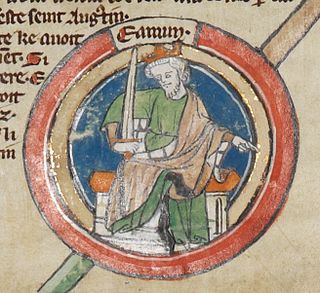
Edmund I or Eadmund I was King of the English from 27 October 939 until his death on 26 May 946. He was the elder son of King Edward the Elder and his third wife, Queen Eadgifu, and a grandson of King Alfred the Great. After Edward died in 924, he was succeeded by his eldest son, Edmund's half-brother Æthelstan. Edmund was crowned after Æthelstan died childless in 939. He had two sons, Eadwig and Edgar, by his first wife Ælfgifu, and none by his second wife Æthelflæd. His sons were young children when he was killed in a brawl with an outlaw at Pucklechurch in Gloucestershire, and he was succeeded by his younger brother Eadred, who died in 955 and was followed by Edmund's sons in succession.

Eric Haraldsson, nicknamed Eric Bloodaxe, also known as Eirik fratrum interfector was a 10th-century Norwegian ruler. It is widely speculated that he had short-lived terms as King of Norway and twice as King of Northumbria.
Olaf Guthfrithson or Anlaf Guthfrithson was a Hiberno-Scandinavian (Irish-Viking) leader who ruled Dublin and Viking Northumbria in the 10th century. He was the son of Gofraid ua Ímair and great-grandson of Ímar, making him one of the Uí Ímair. Olaf succeeded his father as King of Dublin in 934 and succeeded in establishing dominance over the Vikings of Limerick when he captured their king, Amlaíb Cenncairech, in 937. That same year he allied with Constantine II of Scotland in an attempt to reclaim the Kingdom of Northumbria which his father had ruled briefly in 927. The forces of Olaf and Constantine were defeated by the English led by Æthelstan at the Battle of Brunanburh in 937.
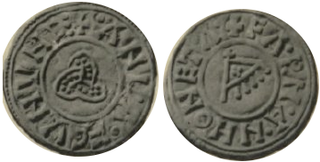
Amlaíb mac Sitric, commonly called Amlaíb Cuarán, was a 10th-century Norse-Gael who was King of Northumbria and Dublin. His byname, cuarán, is usually translated as "sandal". His name appears in a variety of anglicized forms, including Olaf Cuaran, Anlaf Sihtricson and Olaf Sihtricson, particularly in relation to his short-lived rule in York. He was the last of the Uí Ímair to play a major part in the politics of the British Isles.
Wulfstan was Archbishop of York between 931 and 952. He is often known as Wulfstan I, to separate him from Wulfstan II, Archbishop of York.

A moneyer is a private individual who is officially permitted to mint money. Usually the rights to coin money are bestowed as a concession by a state or government. Moneyers have a long tradition, dating back at least to ancient Greece. They became most prominent in the Roman Republic, and continued into the Empire. In Rome the position of Triumvir Monetalis, held by three people at a time, was a minor magistracy awarded by the Senate, often the first office held by a young politician. Marcus Aurelius is one famous example; John Hull is another with his founding of the Hull Mint for the Massachusetts Bay Colony.
Sitric Cáech or Sihtric Cáech or Sigtrygg Gále, was a Hiberno-Scandinavian Viking leader who ruled Dublin and then Viking Northumbria in the early 10th century. He was a grandson of Ímar and a member of the Uí Ímair. Sitric was most probably among those Vikings expelled from Dublin in 902, whereafter he may have ruled territory in the eastern Danelaw in England. In 917, he and his kinsman Ragnall ua Ímair sailed separate fleets to Ireland where they won several battles against local kings. Sitric successfully recaptured Dublin and established himself as king, while Ragnall returned to England to become King of Northumbria. In 919, Sitric won a victory at the Battle of Islandbridge over a coalition of local Irish kings who aimed to expel the Uí Ímair from Ireland. Six Irish kings were killed in the battle, including Niall Glúndub, overking of the Northern Uí Néill and High King of Ireland.

The Uí Ímair, also known as the IvarDynasty or Ivarids was a royal Norse-Gael dynasty which ruled much of the Irish Sea region, the Kingdom of Dublin, the western coast of Scotland, including the Hebrides and some part of Northern England, from the mid 9th century.
Ragnall mac Bárid ua Ímair or Rægnald was a Viking leader who ruled Northumbria and the Isle of Man in the early 10th century. He was a grandson of Ímar and a member of the Uí Ímair. Ragnall was most probably among those Vikings expelled from Dublin in 902, whereafter he may have ruled territory in southern Scotland or the Isle of Man. In 917, he and his kinsman Sitric Cáech sailed separate fleets to Ireland where they won several battles against local kings. Sitric successfully recaptured Dublin and established himself as king, while Ragnall returned to England. He fought against Constantín mac Áeda, King of Scotland, in the Battle of Corbridge in 918, and although the battle was not decisive it did allow Ragnall to establish himself as king at York.
Gofraid ua Ímair or Guthfrith of Ivar was a Hiberno-Scandinavian and Viking leader who ruled Dublin and briefly Viking Northumbria in the early 10th century. He was a grandson of Ímar and a member of the Uí Ímair. Gofraid was most probably among those Vikings expelled from Dublin in 902, whereafter he helped his kinsman Ragnall conquer Northumbria. Another kinsman, Sitric Cáech, became ruler of Dublin around the same time. Ragnall died in 920, and so the following year Sitric left Dublin to rule in Northumbria, and Gofraid succeeded Sitric as ruler of Dublin. Sitric's early reign was marked by raids he conducted against the Gaelic (Native-Irish), including one at Armagh.
Events from the 10th century in the Kingdom of England.
Blácaire mac Gofraid was a Viking leader who ruled Dublin in the 10th century. He succeeded his brother Amlaíb mac Gofraid as king in 939 after the latter left Dublin to rule Northumbria. In the early years of his reign Blácaire led raids on important Christian sites at Clonmacnoise and Armagh, but repeated attacks by the Irish of Leinster in 943 and 944 led to the sack of Dublin. A year later Blácaire was replaced as King of Dublin by his cousin Amlaíb Cuarán, who had succeeded Blácaire's brother in Northumbria in 941, but had been driven out in 944.
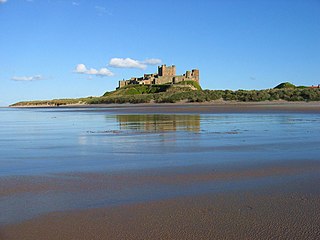
From the destruction of the Anglo-Saxon Kingdom of Northumbria by the Vikings in 867 to the early eleventh century, Bamburgh and the surrounding region, the northern part of Northumbria, was ruled for a short period by shadowy kings, then by a series of ealdormen and high-reeves. Several of these men ruled all Northumbria.
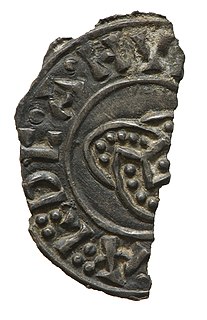
Ragnall Guthfrithson was a Viking leader who ruled Viking Northumbria in the 10th century. He was the son of Gofraid ua Ímair and great-grandson of Ímar, making him one of the Uí Ímair. He ruled Northumbria in 943 and 944, either with, or in opposition to, Olaf Cuaran. Ragnall and Olaf were driven out of Northumbria by the English in 944. His later life is unknown but it is possible he was the "king of the Danes" who is reported as being killed by the Saxons at York in 944 or 945.

Viking coinage was used during the Viking Age of northern Europe. Prior to the usage and minting of coins, the Viking economy was predominantly a bullion economy, where the weight and size of a particular metal is used as a method of evaluating value, as opposed to the value being determined by the specific type of coin. By the ninth century, the Viking raids brought them into contact with cultures well familiarised with the use of coins in economies of Europe, hence influencing the Vikings own production of coins.
The Battle of Islandbridge, also called the Battle of Áth Cliath, took place on 14 September 919, between a coalition of native Irish, led by Niall Glúndub, overking of the Northern Uí Néill and High King of Ireland, and the Dublin-based Vikings of the Uí Ímair, led by Sitric Cáech. It was one in a series of battles initiated by the native Irish to attempt to drive the Vikings of the Uí Ímair from Ireland. The battle was a decisive victory for Sitric Cáech and the Uí Ímair, with Niall Glúndub and five other Irish kings dying in the battle.
The Battle of Mag Femen took place on 22 August 917 between the Vikings of the Uí Ímair, led by Ragnall, a grandson of Ímar, and the Irish of the Northern Uí Néill, led by Niall Glúndub, High King of Ireland. It was one of two battles involving the Uí Ímair that year, the other being the Battle of Confey, which occurred as a result of the Uí Ímair trying to retake the Kingdom of Dublin which they had lost in 902. The battle began when Niall Glúndub's forces attacked a Viking army at a site identified by the annals as Topar Glethrach in Mag Femen. The Irish initially inflicted the majority of the casualties, but late in the day a host of more troops led by Ragnall reinforced the Viking army, securing victory for the Uí Ímair.
Harald Sigtryggsson was a Viking leader who ruled Limerick in the early 10th century. He was the son of Sitric Cáech and great-grandson of Ímar, making him one of the Uí Ímair. He was installed as king of Limerick following the capture of the previous king Olaf Scabby-head by Harald's cousin Olaf Guthfrithson, king of Dublin, during a battle at Lough Ree in 937. Harald died in 940 and was ultimately succeeded by Ivar of Limerick.
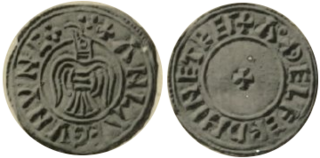
The Raven Penny is a coin of the Viking Olaf Guthfrithson who was the king of Dublin between 934–941.
References
Citations
Secondary sources
- Downham, Clare (2007). Viking Kings of Britain and Ireland: The Dynasty of Ívarr to A.D. 1014. Edinburgh: Dunedin Academic Press. ISBN 978-1-903765-89-0.
- Gooch, Megan L. (2012). Money and Power in the Viking Kingdom of York c.895–954 (Thesis). Durham University.
- Grierson, Philip; Blackburn, Mark A. S. (1986). Medieval European Coinage: With a Catalogue of the Coins in the Fitzwilliam Museum, Cambridge. Cambridge University Press. ISBN 978-0-521-03177-6.
- Lake, Justin (2013). Richer of Saint-Remi. CUA Press. ISBN 978-0-8132-2125-0.
- Richer of Saint-Rémi (5 September 2011). Lake, Justin (ed.). Histories. Harvard University Press. ISBN 978-0-674-06003-6.
- Skingley, Philip, ed. (2014). Coins of England & the United Kingdom: Standard Catalogue of British Coins 2015. Spink & Sons Ltd. ISBN 978-1-907427-43-5.